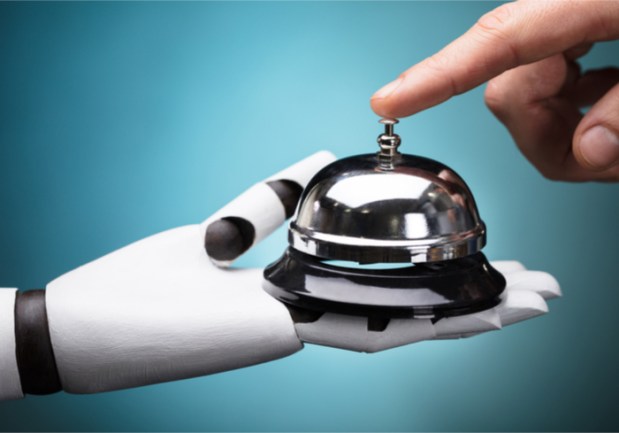Robots Serve Up Innovation (And Food) In Restaurants

Restaurant robots aren’t just for flipping burgers or preparing pizzas: They can also work in the front of the house and serve customers. Bear Robotics’ Penny, for example, is an autonomous runner and busser. As an assistant to staff, Penny can take food directly from the kitchen to a programmed table in the dining room. Weight sensors determine when customers takes their plates from Penny, so she can move onto the next task. But Penny can serve customers more than just their meals: She can also bring customers additional cutlery, or even the check. In all, “she’s able to do quite a lot,” Bear Robotics, Inc. Chief Operating Officer Juan Higueros told PYMNTS.com in an interview.
Robots such as Penny can even work in crowded spaces and navigate around diners. Penny, for example, is able to see if people are approaching, and is able to maneuver around them using sensors that detect humans and other objects. She can say “excuse me” as she moves around customers and Higueros said she doesn’t have any blind spots. Penny can also be programmed to say a message when delivering food, but, for now the communication is just one-way. In terms of energy, Penny’s battery can work for up to eight hours, allowing her to work for long periods of time.
The Server Of The Future
For restaurant owners, robots such as Penny can help provide backup for staff that might not be able to make their shifts. With Penny, “there’s always a dependable resource that’s able to do at least the running of the food and maybe help with the bussing,” Higueros said. Beyond serving customers, Penny can be used to ease the workload of her human coworkers. Staff can place dishes on Penny and have her take them back to the kitchen — instead of making the trip themselves. With Penny, the idea is to free up staff to do other things — and take some of the pressure off of them. In addition, Penny can provide a marketing opportunity: Bear Robotics has had some people interested in putting an advertising wrap on the robot.
In terms of testing, Bear Robotics has been piloting Penny with a restaurant group in California. The group had asked Bear to test it during family nights because it felt like it would be a good idea to try it out with a variety of audiences. Higueros said that the reactions have been “delightful” from patrons of all ages — and the pilot provides a good opportunity for feedback on how to address the next version. The specter of the robot also, of course, draws in customers. “They do like to try [to] see it, and see what it’s all about,” Higueros said.
Going forward, Bear Robotics hopes to add more features and capabilities to Penny. While Penny can only handle one tray now, Higueros is hoping that she can add another tray in the future. Bear Robotics is also looking to have Penny deliver beverages, such as pints of water or soda. In addition, Bear wants to have multiple robots working in tandem at a restaurant. “Think of it as multi-robot collaboration,” Higueros said, adding that there could be revolving communication between robots. In terms of payment technology, Bear Robotics also hopes to integrate a point of sale (POS) system in the future, but for now, Penny can deliver a check.
The World Of Restaurant Robots
Beyond Penny, Zume Pizza is using robots and humans to make and deliver pizza in the U.S. The robots are used for repetitive tasks, such as spreading tomato sauce onto the pizzas and placing them in the ovens. Recipe development, food prep and pizza tasting are left to humans. Zume isn’t the only company embracing technology when it comes to making pizza. Pizzas at Costco, for example, are now also made with the help of automation. A mechanical saucing process distributes tomato sauce over the base of the pizza — making it easier to create pies in bulk — while spreading the sauce evenly and all the way to the crust.
For other cuisines, Pasadena, California-based startup Miso Robotics has introduced Flippy, the automated fast-food burger-flipper. Miso’s burger bot can flip burgers twice as fast as a human, using its singular arm, and it is powered by deep machine learning. Robots such as Flippy can eliminate uncertainty and inconsistency, allowing restaurants to deliver exactly the burger you ordered every time. Flippy monitors the temperature of burger patties as it cooks them to ensure each one is heated to industry standards. That serves the dual purpose of delivering a consistent product that matches the customer’s expectations, while also increasing food safety by meeting regulations.
How soon will robots like Penny become a common fixture in restaurants? That remains to be seen, but with all their abilities, robots have the potential to be the chefs, servers and bussers of the future.
